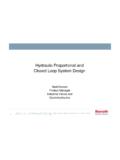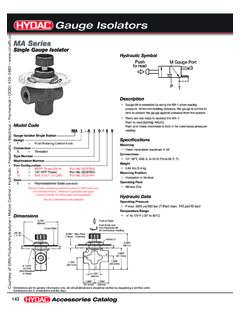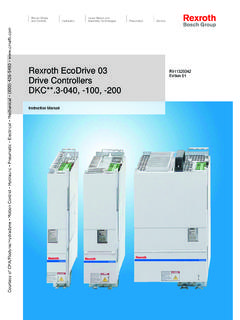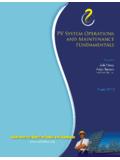Transcription of Arc Flash: NFPA 70E Workplace Safety
1 arc flash : nfpa 70E Workplace Safety Product Management / Piero Fagiolo / April 2014 1. Drive for Technology Expo Product Management / Piero Fagiolo / April 2014 2. arc flash : nfpa 70E. Workplace Safety arc flash Definition nfpa 70E. arc flash Prevention Rittal Solutions Summary Product Management / Piero Fagiolo / April 2014 3. What is arc flash ? An arc flash is an explosion resulting from an electrical short circuit Air acts as a conductor to carry current which causes an arc fault This arc fault may be caused by a dropped tool, the buildup of conductive dust, or corrosion arc flash explosions are very powerful and are capable of causing severe burns, injury, or death Product Management / Piero Fagiolo / April 2014 4.
2 What is arc flash ? arc flash is a serious hazard 2,000 workers per year are admitted to burn centers for treatment of severe arc flash burns In the United States, the federal agency OSHA (Occupational Safety & Health Administration) regulates work place Safety for arc flash OSHA's rules are based on the requirements of the National Fire Prevention Association ( nfpa ). nfpa 70E Standard Source: Electrical Safety Foundation International (ESFI). Product Management / Piero Fagiolo / April 2014 5. arc flash Statistics Did you know? 5 to 10 arc flash accidents occur every day in the More than 2,000 people are treated annually in burn centers with arc flash injuries 1-2 deaths occur per day from an arc flash incident $ average cost of medical treatment 8-12 months away from work and possibility of permanent disability $10-15M average litigation cost for general industry incident Two-thirds of all electrical injuries result from inappropriate action of a worker arc flash can reach temperatures upwards of 30,000 F (hotter than the surface of the Sun).
3 Arc Blasts can produce a pressure wave greater than 2,000 lbs/sqft 480 volts often times has a greater arc flash potential than medium voltage gear (4,160V and above). Source: Falcon Engineering Consultants Product Management / Piero Fagiolo / April 2014 6. nfpa 70E. Standard for Electrical Safety in the Workplace The purpose of this standard is to provide a practical safe working area for employees relative to the hazards arising from the use of electricity Tailored to fulfill OSHA's responsibilities that is consistent with the NEC. Considered to be a manual of how to comply with OHSA regulations nfpa 70E covers Safety Related Work Practices, Safety Related Maintenance Requirements and Requirements for Special Equipment arc flash Hazard Analysis (potential exposure to arc flash energy).
4 Determination of safe work practices, arc flash boundary, and appropriate levels of PPE (personal protective equipment). Product Management / Piero Fagiolo / April 2014 7. nfpa 70E. arc flash Boundary 3 feet at fewer than 750 volts 19 feet at voltages of 15kV to 36kV. arc flash Boundary distance from an exposed energized electrical conductor or circuit ref. (c)(a,b). Limited shock hazard exists Restricted increased risk of shock from electrical over arc Prohibited considered same as making contact Product Management / Piero Fagiolo / April 2014 8. nfpa 70E. Labeling of Hazards energized panels or boards must be marked with danger or warning signs that indicate the potential hazard Product Management / Piero Fagiolo / April 2014 9.
5 nfpa 70E. Personal Protective Equipment (PPE). Protective clothing and equipment rated according to the amount of energy that would cause second-degree burns to exposed skin (5 J/cm ). PPE is required if an employee must go within an arc flash boundary Eye protection - face shield or Safety glasses Non-conductive head protection (when danger of head injury). Body protection arc rated clothing (must not melt below 600F). Hearing protection Hand and arm in accordance to (c)(a-c). Shock protection - rubber insulated gloves with leather protectors Foot insulated leather boots required when the arc flash energy level is high Product Management / Piero Fagiolo / April 2014 10.
6 nfpa 70E. Personal Protective Equipment Levels Additional equipment required other than listed below Least potential of arc flash danger Highest potential of arc Source: Lewellyn Technology flash danger Product Management / Piero Fagiolo / April 2014 11. Routine Opening and Closing of Circuits Require load rated switches, circuit breakers, or other devices specifically designed as a disconnecting means under load conditions Means to shutoff/disconnect incoming power Lockout/Tag out A lockout or tag out program is required when work must be done on machinery Each worker has a lock or tag that is placed on the energy source before beginning work and removed when finished The machine may be powered up only after determined the circuit can safely be energized and every lock or tag is removed Product Management / Piero Fagiolo / April 2014 12.
7 Examples of Isolating Main Line Side Power Small enclosure on main enclosure Separate line side power outside main enclosure Difficult to separate low and high voltage Aesthetics not good Un-useable floor space Potential Workplace obstruction hazard Small enclosure inside main enclosure Line side power inside main enclosure in separate Type 1 enclosure Live power still in enclosure being worked on Modular TS8 enclosure attached to enclosure suite Separate line side power outside main enclosure Aesthetics are pleasing Cabinet can be used for other energized parts Design allows for separation of high and low voltage Product Management / Piero Fagiolo / April 2014 13.
8 TS8 Modular Design Benefits Can isolate low voltage (<50v) components in separate cabinet to allow diagnostics and testing of energized compartment (minimal PPE). All cabinets can be interlocked (do not need to interlock low voltage if using barrier). Modular design allows expansion with standard components Aesthetics with out obstruction hazard Power Enclosure Isolation Enclosure (houses line side (High Voltage). power). Control Enclosure Flange Mount (Low Voltage Disconnect Door <50v). Product Management / Piero Fagiolo / April 2014 14. TS8 Modular Design Benefits Overhead Interlocking: Safety - doors cannot be opened when power is on Disconnect and main line power in cabinet outside disconnect cabinet If a low voltage is separated, cabinet no interlocking required Allows access with minimal PPE.
9 Partition wall between enclosures to seal off access Overhead Door to Door Interlocking Power Enclosure Partition Wall (High Voltage). Product Management / Piero Fagiolo / April 2014 15. TS8 Modular Design Benefits All enclosures separated by partition walls Control enclosures housing low voltage does not need to be interlocked Isolation Enclosure (houses line side Power power). Control Enclosure Enclosure (High Voltage). (Low Voltage <50v). Product Management / Piero Fagiolo / April 2014 16. arc flash Safety and Prevention arc flash Assessment An arc flash assessment determines the potential for an arc flash (electrical arc) and the possible intensity of that arc flash This is critical information needed by anyone who will be working on or near energized electrical parts, switches, breakers or equipment Calculations can be found in IEEE 1584 (Guide for Performing Arc- flash Hazard Calculations).
10 Standard of the Institute of Electrical and Electronics Engineers that provides a method of calculating the incident energy of arc flash events Reasons to complete an arc flash hazard assessment Comply with NESC 410A3 (National Electric Safety Code) and the OSHA. General Duty Clause (place of employment free from recognized hazards). Provides information required to be on arc flash labels Provides for the correct selection of (PPE). Allows complete and appropriate training to be provided Identifies the appropriate tools needed for working on energized equipment Source: Steve Hudgik at Product Management / Piero Fagiolo / April 2014 17. arc flash Safety and Prevention Conduct regular arc flash hazard assessments Reduce human error by offering regular Safety training to personnel Ensure that workers wear necessary personal protective equipment and follow Safety procedures Isolate main line side power to minimize exposure of personnel Product Management / Piero Fagiolo / April 2014 18.












